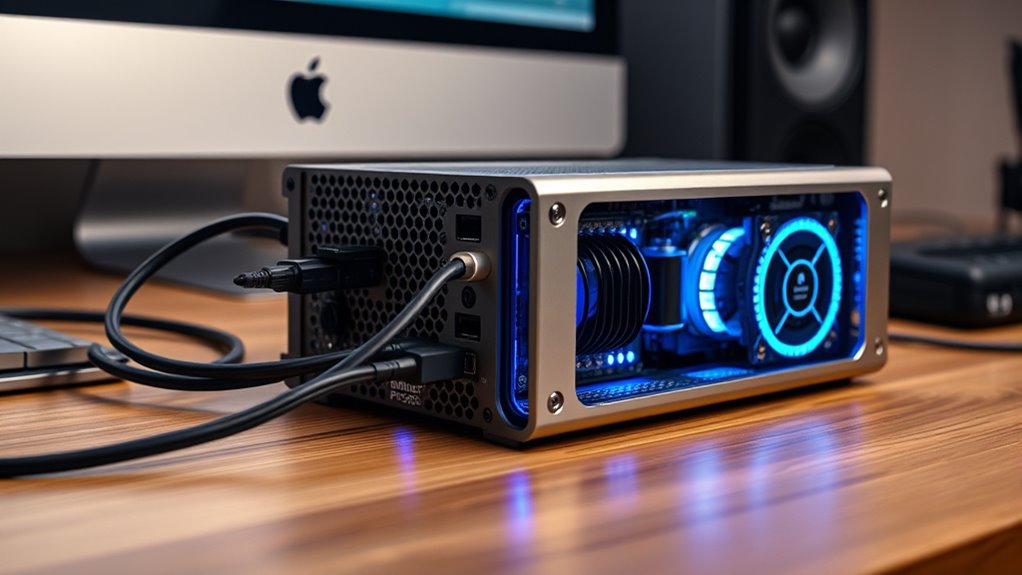If you’re looking for the best Thunderbolt PCIe expansion chassis for your Mac Studio in 2025, I recommend checking out options like the StarTech Thunderbolt 3 chassis, Maskedfish MK-T2L, RocketStor 6661B, and Sonnet’s Echo Express SEL and xMac Studio. These support high-speed data transfer, multiple PCIe cards, and are compatible with macOS and Windows. Each offers different features like cooling, rackmounting, or dual slots. Keep reading to learn which one fits your needs perfectly.
Key Takeaways
- Consider compatibility with Mac Studio’s Thunderbolt 3/4 ports and support for high-performance PCIe cards up to 8 inches long.
- Evaluate cooling solutions like passive aluminum or active fans for thermal management during intensive workflows.
- Look for models with sufficient bandwidth (up to 40Gbps) and optional additional ports such as DisplayPort or USB hubs.
- Choose versatile options offering single or dual PCIe slots, including rackmount or portable designs based on workspace needs.
- Assess build quality, support, and future-proof features like driverless operation and TAA compliance for reliable, long-term use.
StarTech Thunderbolt 3 PCIe Expansion Chassis
If you’re looking to expand your Mac Studio’s capabilities with a reliable, high-speed PCIe solution, the StarTech Thunderbolt 3 PCIe Expansion Chassis is an excellent choice. It adds an external PCIe x16 slot via Thunderbolt 3 or 4, supporting single-width cards up to 8 inches long. Built with durable aluminum and steel, it’s portable yet sturdy. With support for PCIe 3.0 x16, you can add video capture cards, NVMe drives, Ethernet, or fiber adapters. It features a dedicated DisplayPort, a second Thunderbolt port for daisy chaining, and delivers up to 40Gbps bandwidth. Plus, its toolless design makes installation straightforward, making it perfect for professional workflows.
Best For: professionals and creatives who need a reliable, high-speed external PCIe expansion for their Mac Studio or other compatible devices to enhance video, data, and connectivity capabilities.
Pros:
- Supports PCIe 3.0 x16 slot for high-performance expansion options
- Durable all-metal design with toolless installation for convenience
- Delivers up to 40Gbps bandwidth and supports multiple high-resolution displays
Cons:
- Limited to single-width PCIe cards up to 8 inches long
- Requires Thunderbolt 3 or 4 port, which may not be available on all devices
- Power delivery capped at 25W via PCIe slot, potentially limiting some high-power cards
Thunderbolt 3/4 USB4 PCIe Expansion Chassis
The Maskedfish Thunderbolt 3/4 USB4 PCIe Expansion Chassis (MK-T2L) stands out as an excellent choice for professionals who need to expand their Mac Studio’s capabilities without sacrificing portability or performance. It adds two PCIe 3.0 x16 slots, supporting cards up to 200x145x25mm, and connects via Thunderbolt 3/4 or USB4. With 40Gbps bandwidth, it handles high-performance cards for video, networking, NVMe SSDs, and audio. The chassis features a durable aluminum build, passive cooling for silent operation, and a 120W power supply. Its additional DisplayPort 1.4 output boosts connectivity, making it a versatile, driverless solution for demanding workflows.
Best For: professionals and power users seeking a portable, high-performance PCIe expansion solution for Mac, Windows, or Linux systems via Thunderbolt 3/4 or USB4.
Pros:
- Supports demanding PCIe cards including video capture, networking, NVMe SSDs, and audio.
- Durable all-aluminum enclosure with passive cooling ensures silent operation and effective heat dissipation.
- Provides 40Gbps Thunderbolt bandwidth and additional DisplayPort 1.4 output for versatile connectivity.
Cons:
- Compatibility with some PCIe cards may require manufacturer drivers, despite driverless setup.
- Size and weight (8.46 x 3.27 x 5.98 inches, 1.9 pounds) may limit portability for very tight spaces.
- Available first on April 28, 2025, which may delay immediate purchase or deployment.
RocketStor 6661B Dual 40Gb/s ThunderboltTM 3 PCIe Expansion Chassis
Designed for professionals who need maximum performance, the RocketStor 6661B offers dual 40Gb/s Thunderbolt 3 ports that deliver blazing-fast data transfer speeds. It supports daisy chaining up to six devices, making it highly versatile for demanding workflows. This chassis can hold one full-height, full-length PCIe card, including NVMe AICs, USB, and Mini-SAS connectivity options. Its dual ultra-quiet fans ensure excellent thermal management during intensive tasks. Compact and reliable, the RocketStor 6661B is ideal for high-performance applications requiring fast data access and multiple device connections, making it a solid choice for Mac Studio users seeking expansion flexibility.
Best For: professionals and high-performance users needing fast data transfer, versatile device connectivity, and PCIe expansion in a compact Thunderbolt 3 chassis.
Pros:
- Supports dual 40Gb/s Thunderbolt 3 ports with daisy chaining up to 6 devices for extensive connectivity.
- Accommodates one full-height, full-length PCIe card, including NVMe AICs, USB, and Mini-SAS options for flexible expansion.
- Equipped with dual ultra-quiet, high-efficiency fans ensuring optimal thermal management during demanding tasks.
Cons:
- Limited to one PCIe card, which may restrict expansion for users needing multiple cards.
- Requires Thunderbolt 3-compatible devices for optimal performance, limiting compatibility with older systems.
- The chassis’s compact size might restrict certain larger PCIe cards or complex configurations.
Sonnet Echo Express SEL Thunderbolt 3-to-PCIe Expansion Chassis
For users needing a compact yet powerful PCIe expansion solution, the Sonnet Echo Express SEL Thunderbolt 3-to-PCIe Expansion Chassis stands out. It features a single low-profile PCIe slot, making it ideal for space-constrained setups. With Thunderbolt 3 support, it delivers 40Gbps bandwidth, enabling data transfers up to 2750 MB/s—twice as fast as Thunderbolt 2. Its small size and portability don’t compromise performance, supporting high-performance, Thunderbolt-compatible PCIe cards. Plus, it supports daisy-chaining up to five devices and includes a 0.7-meter Thunderbolt cable and retainer clip, ensuring secure connections. It’s a versatile, reliable solution for expanding your Mac Studio or PC.
Best For: professionals and creatives needing a portable, high-speed PCIe expansion solution for their Mac or Windows PC via Thunderbolt 3.
Pros:
- Supports high-performance Thunderbolt-compatible PCIe cards at full bandwidth of 40Gbps.
- Compact, portable design ideal for space-constrained setups without sacrificing speed.
- Includes essential accessories like a 0.7-meter Thunderbolt 3 cable and retainer clip for secure, reliable connections.
Cons:
- Only has a single low-profile PCIe slot, limiting expansion options.
- Compatibility is limited to Thunderbolt 3-enabled devices; cannot connect directly to non-Thunderbolt ports.
- Customer feedback indicates a higher price point compared to some alternatives with fewer features.
Sonnet Technologies xMac Studio 3U Rackmount Enclosure
If you’re looking to expand your Mac Studio’s capabilities while keeping your workspace organized, the Sonnet Technologies xMac Studio 3U Rackmount Enclosure is a fantastic option. It fits neatly into a 3U rack, housing your Mac Studio alongside two PCIe expansion cards, perfect for professional workflows. The 400-watt power supply supports the entire system, while the built-in USB-A hub adds convenient peripheral connections. Equipped with two Noctua fans, it ensures quiet cooling, making it suitable for busy studio environments. Weighing just a pound, it combines compactness with robust functionality, enhancing your setup without sacrificing space or performance.
Best For: professional Mac Studio users seeking a compact, organized, and quiet rackmount solution for expanding their system with PCIe cards and additional storage.
Pros:
- Supports Mac Studio and two PCIe expansion cards, enhancing device flexibility
- Quiet operation with dual Noctua temperature-controlled fans, ideal for studio environments
- Compact 3U rackmount design with built-in USB-A hub for convenient peripheral connectivity
Cons:
- Weighs only 1 pound, which may raise concerns about durability and robustness over time
- Storage expansion limited to three SSDs, which may not meet all high-capacity needs
- Compatibility is limited to Mac Studio units; not suitable for other computer models
StarTech Thunderbolt 3 PCIe Expansion Chassis
The StarTech Thunderbolt 3 PCIe Expansion Chassis stands out as an ideal choice for professionals seeking versatile external PCIe support without compromising portability. It supports dual PCIe 3.0 x16 slots, accommodating single-width cards up to 8 inches long, and works seamlessly with macOS and Windows—driverless and TAA-compliant. Its toolless design makes installation straightforward, while the active cooling fan ensures thermal management. With 32Gbps bandwidth, it supports high-speed devices like NVMe drives, capture cards, and Ethernet adapters. The chassis also enables stunning display options with 8K, 5K, or dual 4K resolutions via DP 1.4 and Thunderbolt ports, making it a flexible, powerful solution for demanding workflows.
Best For: professionals and power users who need versatile, high-speed external PCIe expansion for demanding workflows and high-resolution display setups.
Pros:
- Supports dual PCIe 3.0 x16 slots with high bandwidth of 32Gbps, ideal for fast data transfer and multiple high-performance devices
- Compatible with macOS and Windows, driverless and TAA-compliant, ensuring broad usability and compliance
- Active cooling fan and toolless design facilitate easy installation and effective thermal management
Cons:
- Supports single-width cards only, excluding full-length or larger PCIe cards such as GPUs
- Limited to cards up to 8 inches long, which may restrict certain high-end or specialized device options
- Requires external power supply and Thunderbolt connection, which may limit portability compared to more compact solutions
Sonnet Echo III Rackmount Thunderbolt 3 to PCIe Card Expansion System
The Sonnet Echo III Rackmount Thunderbolt 3 to PCIe Card Expansion System stands out as an ideal choice for professionals who need to seamlessly expand their Mac Studio’s capabilities with multiple PCIe cards. It offers three slots—one x16 and two x8—and supports a wide range of cards, including full-height and double-width options. With a robust 400W power supply and compatibility across Linux, Mac OS, and Windows 10, it’s perfect for high-performance workflows. Its rackmount design and automatic power features make it suitable for professional audio, video, and computing environments, providing reliable, flexible expansion for demanding users.
Best For: professionals seeking to expand their Mac Studio or compatible computer’s PCIe connectivity with multiple high-performance cards in a reliable rackmount system.
Pros:
- Supports up to three PCIe cards, including full-height and double-width options, offering versatile configuration.
- Compatible with multiple operating systems (Linux, Mac OS, Windows 10), ensuring broad usability.
- Equipped with a powerful 400W power supply and automatic on/off synchronization for stable, efficient operation.
Cons:
- Heavier and bulkier due to rackmount design, potentially requiring dedicated space and installation effort.
- Higher price point reflective of professional-grade hardware, which may be a consideration for budget-conscious users.
- Limited to Thunderbolt 3 connectivity, which might require additional adapters or considerations for certain setups.
Thunderbolt 3 to PCIe Card Dock
For professionals seeking versatile PCIe expansion, the Thunderbolt 3 to PCIe Card Dock (TD1) by ANQUORA stands out with its driverless operation and broad compatibility. It supports PCIe 3.0 x16 cards for laptops and desktops with Thunderbolt 3/4 or USB4, fitting cards up to 163mm x 28mm x 121mm. With up to 40Gbps bandwidth via Thunderbolt 3, it handles high-speed devices like NVMe drives, video capture cards, and Ethernet adapters. Its all-aluminum chassis offers passive cooling and a silent operation, making it a reliable, compact, and versatile solution for expanding your PCIe options without hassle.
Best For: professionals and power users seeking versatile PCIe expansion for high-speed devices on laptops or desktops with Thunderbolt 3/4 or USB4 connectivity.
Pros:
- Supports PCIe 3.0 x16 cards up to 163mm x 28mm x 121mm, offering broad compatibility.
- Achieves high data transfer speeds of up to 40Gbps via Thunderbolt 3 for demanding applications.
- All-aluminum chassis provides passive cooling and silent operation, ensuring durability and quiet performance.
Cons:
- Does not support GPU cards due to limited power supply (36W).
- Requires compatible Thunderbolt 3/4 or USB4 ports; not suitable for systems without these interfaces.
- Power is supplied through the PCIe slot, which may limit usage with certain high-power or specialized cards.
Sonnet Echo III Desktop Thunderbolt 3 to PCIe Card Expansion System
If you’re looking to expand your Mac Studio’s PCIe capabilities, the Sonnet Echo III Desktop Thunderbolt 3 to PCIe Card Expansion System stands out as an excellent choice, especially for professionals needing versatile connectivity. It supports up to three high-performance PCIe cards via Thunderbolt 3, including non-GPU options, making it compatible with systems lacking expansion slots. With three PCIe 3.0 slots—one x16 and two x8—it handles full-height, single-width or mixed configurations. Its 400W power supply and automatic on/off features guarantee reliable operation. Designed for audio, video, and computing tasks, it offers flexible connectivity tailored for demanding professional workflows.
Best For: professionals and creatives who need versatile PCIe expansion for high-performance audio, video, and computing applications on systems lacking internal slots.
Pros:
- Supports up to three high-performance PCIe cards via Thunderbolt 3, including non-GPU options
- Compatible with systems without internal PCIe slots, expanding hardware capabilities easily
- Features a robust 400W power supply with automatic on/off for reliable operation
Cons:
- Requires Thunderbolt 3 connection, limiting compatibility to Thunderbolt-enabled systems
- May be larger and less portable compared to internal expansion options
- Limited to three PCIe slots, which might not suffice for users needing more expansion slots
USB4 to PCIe Expansion Card for Thunderbolt 4/3 (Compatible with eGPU and PCIe Data Capture Boards)
A USB4 to PCIe expansion card stands out as an essential solution for professionals seeking to maximize their Thunderbolt 4 or 3 ports, especially when connecting high-performance peripherals like eGPUs or PCIe data capture boards. It enables laptops and desktops to interface with PCIe devices through USB4 or Thunderbolt, supporting data capture cards, SSDs, RAID arrays, and more. With high-speed transfers up to 40Gbps, multiple PCIe configurations, and compatibility across Windows, macOS, and Linux, it offers flexible system expansion. Its compact design and robust performance make it ideal for professionals who need reliable external PCIe connectivity without internal modifications.
Best For: professionals and gamers seeking to expand their system’s PCIe capabilities via Thunderbolt 4/3 ports for high-performance peripherals like eGPUs, data capture cards, and storage arrays.
Pros:
- Supports high-speed data transfer up to 40Gbps, suitable for demanding PCIe devices.
- Compatible with multiple operating systems including Windows, macOS, and Linux.
- Compact design with flexible PCIe slot configurations (x1, x4, x8, x16) for versatile system expansion.
Cons:
- Requires Thunderbolt or USB4 port on the host device, limiting compatibility with older systems.
- May need technical expertise for installation and configuration.
- Limited information on bundled accessories or additional support features.
ASUS ThunderboltEX 5 Expansion Card
The ASUS ThunderboltEX 5 Expansion Card stands out as an excellent choice for high-performance setups requiring rapid data transfer and versatile connectivity. Designed for Intel 800 Series motherboards, it features dual Thunderbolt 5 USB-C ports, PCIe 4.0 x4 interface, and DisplayPort 2.1 support. With bandwidth up to 120 Gbps, it enables daisy-chaining of five Thunderbolt devices, delivering superfast data transfer and high-resolution video output, including three 8K displays at 60Hz. Its dual USB-C ports support up to 130W power delivery, making it ideal for demanding professional workflows. Overall, it offers robust, future-proof connectivity for Mac Studio users in 2025.
Best For: professionals and enthusiasts seeking high-speed data transfer, versatile connectivity, and high-resolution video output for demanding workflows on Intel 800 Series motherboards.
Pros:
- Supports up to five Thunderbolt devices daisy-chained with 120 Gbps bandwidth for fast data and video transfer
- Dual USB-C ports deliver up to 130W power delivery for charging multiple devices simultaneously
- Compatible with DisplayPort 2.1, enabling connection to three 8K 60Hz displays for high-resolution visuals
Cons:
- Designed specifically for Intel 800 Series motherboards, limiting compatibility with other systems
- Requires PCIe 4.0 x4 slot, which may not be available on older or budget motherboards
- May be overkill for users with basic connectivity needs or lower-resolution display requirements
MSI ThunderboltM4 8K PCI-e Dock
Extremely high data transfer speeds and reliable multi-device connectivity make the MSI ThunderboltM4 8K PCI-e Dock ideal for professionals who demand top-tier performance. It features dual Thunderbolt 4 ports and supports daisy chaining of up to six devices, making it perfect for complex setups. With a multi-port accessory architecture, it’s the best single-cable docking solution for seamless peripherals integration. Its ability to deliver a full 8K UHD display experience and transfer data at 40 Gbps ensures smooth workflows. Designed for high-performance use, it supports PCIe 8K Thunderbolt M.2 cards with minimal latency, making it perfect for demanding audio and visual tasks.
Best For: professionals and power users who require high-speed data transfer, multi-device connectivity, and 8K display support for demanding audio-visual tasks.
Pros:
- Supports full 8K UHD display for immersive visual experiences
- Unmatched 40 Gbps data transfer rate ensures rapid workflows
- Daisy chaining of up to six devices simplifies complex setups
Cons:
- May require compatible Thunderbolt 4-enabled devices for optimal performance
- Potentially higher cost due to advanced features and high-end performance
- Limited compatibility with non-Thunderbolt or older systems
ASUS ThunderboltEX 4 with Intel Thunderbolt 4 Controller
If you’re seeking a Thunderbolt expansion card that delivers ultrafast connectivity and robust display support, ASUS ThunderboltEX 4 stands out thanks to its Intel Thunderbolt 4 Controller. It supports Thunderbolt 4 and USB 4 technology, offering two Type-C ports with up to 40Gb/s bandwidth. You can daisy-chain up to five Thunderbolt devices easily. It also features two mini DisplayPort 1.4 ports, supporting 8K resolution and VGA input, with a maximum screen resolution of 7680×4320. Additionally, it provides up to 100W power delivery, making it ideal for fast charging compatible devices. Compatibility is limited to ASUS motherboards, but it excels in performance and display support.
Best For: users needing ultrafast Thunderbolt 4 connectivity, high-resolution display support, and power delivery in an ASUS-compatible expansion card.
Pros:
- Supports Thunderbolt 4 and USB 4 technology with up to 40Gb/s bandwidth.
- Enables daisy-chaining of up to five Thunderbolt-enabled devices.
- Supports up to 8K resolution and VGA input through mini DisplayPort 1.4 ports.
Cons:
- Compatibility limited exclusively to ASUS motherboards.
- Requires Windows 10 64-bit operating system.
- Price and availability may vary across retailers and regions.
PCIe to USB 3.2 Gen 1 Expansion Card
For users seeking reliable and high-speed USB connectivity, the PCIe to USB 3.2 Gen 1 Expansion Card delivers five external ports with a combined bandwidth of up to 20Gbps. It includes three Type A ports and two Type C ports, each supporting transfer speeds up to 10Gbps. Compatible with Windows 7 through 11, macOS (10.8.2+), and Linux (drivers needed for Windows 7), it offers stable internal PCIe expansion. Easy to install, it connects directly to your motherboard slot, making it a solid alternative to external hubs. This card is ideal for connecting external drives, peripherals, or VR devices, ensuring fast, dependable data transfer.
Best For: users seeking a reliable, high-speed internal USB expansion solution for desktops needing multiple high-speed peripherals.
Pros:
- Supports five external USB ports with a total bandwidth of 20Gbps, ensuring fast data transfer.
- Compatible with Windows 7-11, macOS (10.8.2+), and Linux (drivers needed for Windows 7).
- Easy to install with a straightforward process, providing a stable alternative to external hubs.
Cons:
- Not compatible with Mac OS without additional configuration.
- Requires opening the PC case and inserting the card into a PCIe slot, which may be complex for some users.
- Drivers are needed for Windows 7, potentially complicating setup on older systems.
FANBLACK PCIe to USB 3.2 Gen 2 Expansion Card
The FANBLACK PCIe to USB 3.2 Gen 2 Expansion Card is an excellent choice for users seeking reliable, high-speed USB connectivity directly from their desktop’s PCIe slot. It offers seven external ports—four Type-A and three Type-C—allowing connection to a wide range of peripherals like drives, webcams, and controllers. With a total bandwidth of 20Gbps, each port can transmit data at up to 10Gbps individually. While it supports data transfer only, it doesn’t support fast charging or video output. Easy to install, it’s compatible with Windows, Mac, and Linux, making it a versatile upgrade for high-performance setups.
Best For: users seeking a reliable, high-speed internal USB expansion solution for desktop PCs that need multiple external USB devices with minimal connection issues.
Pros:
- Provides 7 external USB ports (4 Type-A, 3 Type-C) for versatile peripheral connectivity
- Supports 20Gbps total bandwidth with individual ports up to 10Gbps, ensuring fast data transfer
- Easy to install with internal PCIe connection, avoiding common external hub connection problems
Cons:
- Does not support PD fast charging or video output (DP, HDMI, VGA)
- Requires driver installation for Windows XP/Vista/7 and server editions; no drivers needed for Windows 10/11 and Mac OS
- May need modifications like cutting the crossbar for narrow PCIe slots during installation
Factors to Consider When Choosing a Thunderbolt PCIE Expansion Chassis for Mac Studio

When choosing a Thunderbolt PCIe expansion chassis for Mac Studio, I focus on compatibility to guarantee it works seamlessly with my setup. I also consider the number and types of PCIe slots to match my expansion needs, along with power requirements to keep everything running smoothly. Finally, I pay attention to cooling and noise levels to maintain a quiet, efficient workspace.
Compatibility With Mac Studio
Choosing a Thunderbolt PCIe expansion chassis for your Mac Studio requires careful attention to compatibility factors that guarantee seamless integration. First, verify the chassis explicitly states compatibility with Mac Studio or supports Thunderbolt 3 or 4 connections, so setup is straightforward. Confirm it works with macOS and that it either includes necessary drivers or operates driverless to avoid functionality issues. Check that the chassis supports the PCIe cards you plan to use, whether low-profile or full-height, matching your expansion needs precisely. Also, confirm the power delivery capabilities to meet the requirements of your PCIe cards. Finally, review the physical design and connector layout to ensure the chassis fits within your Mac Studio environment and connects properly via the Thunderbolt ports, ensuring a smooth user experience.
Number of PCIe Slots
The number of PCIe slots in a Thunderbolt expansion chassis directly impacts how many cards you can run at once, shaping your system’s overall capabilities. A single-slot chassis supports only one card, perfect if you need minimal expansion. Multi-slot enclosures allow multiple cards, ideal for complex setups involving networking, storage, or video processing. It’s also important to check if the chassis supports mixing different slot sizes, like x16, x8, or x4, to match your specific cards. The number of slots influences the chassis’s size and internal layout, affecting portability and workspace compatibility. Keep in mind, more slots often mean increased power and cooling needs. Choosing the right number depends on your current and future expansion plans, balancing flexibility with practicality.
Supported Card Types
Selecting a Thunderbolt PCIe expansion chassis requires ensuring it supports the specific types and sizes of cards you plan to use. Not all chassis accommodate every card form factor, so check whether it supports low-profile, full-height, or double-width cards based on your needs. It’s also important to verify if the chassis can handle the number and type of cards you require, such as video capture, NVMe, or networking cards. Compatibility with your cards’ interface, whether PCIe x1, x4, x8, or x16, is vital for proper operation. Additionally, confirm that the chassis can supply the necessary power for high-demand cards, especially GPUs. Ensuring these factors align with your professional requirements guarantees a smooth setup and maximum performance.
Power Requirements and Delivery
Ensuring your Thunderbolt PCIe expansion chassis delivers adequate power is essential for supporting high-performance cards and peripherals without issues. Look for a chassis that offers a power delivery range from 25W to 130W to meet various card requirements. Check if it includes an external power adapter capable of providing stable, sufficient wattage, especially if you’re running multiple or power-hungry cards. Confirm the chassis supports Power Delivery (PD) standards compatible with your Mac Studio to enable charging or power sharing through the Thunderbolt connection. Review the power specifications carefully—some cards may need additional power connectors or auxiliary supplies. Considering the total power budget and wattage ratings helps prevent overloading, ensuring reliable, long-term operation of all connected components.
Cooling and Noise Levels
Efficient cooling is crucial when choosing a Thunderbolt PCIe expansion chassis for your Mac Studio, especially if you plan to run high-performance cards for extended periods. Active cooling systems, like built-in fans, help maintain ideal temperatures and prevent overheating during demanding workloads. However, noise levels can vary depending on the cooling design; passive cooling options are quieter and suitable for noise-sensitive environments, while active fans offer better heat dissipation. Proper airflow management within the chassis ensures stable operation and can extend the lifespan of your PCIe cards. Overheating can lead to thermal throttling or hardware failure, so balancing cooling efficiency with noise output is essential, whether you’re in a professional studio, server room, or quiet office setting.
Port and Display Options
When choosing a Thunderbolt PCIe expansion chassis for your Mac Studio, it’s important to pay attention to its port and display options. Look for models that support multiple display outputs, such as DisplayPort 1.4 or 2.1, to handle high-resolution monitors like 4K, 5K, or even 8K. Make sure the chassis provides dedicated video outputs compatible with your display setup, and verify it has enough Thunderbolt ports and daisy-chain capabilities to connect multiple peripherals and screens simultaneously. Consider whether it supports external video connections via Thunderbolt or additional ports for expanded options. Ultimately, confirm that it can accommodate the necessary video cards or adapters needed for your desired display configurations, ensuring seamless performance across your setup.
Frequently Asked Questions
Can These Chassis Support Multiple PCIE Cards Simultaneously?
Yes, many Thunderbolt PCIe expansion chassis can support multiple PCIe cards at once. I’ve checked several models, and those with larger enclosures and more PCIe slots typically handle two or more cards comfortably. Just keep in mind the chassis’s power and bandwidth limits. I recommend looking for one with enough slots and proper cooling to ensure stability when running multiple cards simultaneously.
Are These Expansion Chassis Compatible With Future Mac Studio Updates?
Think of these expansion chassis as sturdy bridges. I’ve found they’re generally compatible with future Mac Studio updates, acting as reliable pathways for upgrades. While I can’t promise absolute future-proofing, most high-quality models now support evolving macOS and hardware needs. Just like a well-built bridge adapts to new traffic, these chassis tend to accommodate future tech, but it’s wise to check manufacturer updates to stay ahead.
What Is the Maximum Power Output for High-Performance PCIE Cards?
The maximum power output for high-performance PCIe cards typically ranges from 75 to 300 watts, depending on the card. For example, high-end GPUs like the Nvidia RTX series often require around 250-300 watts, while other cards may need less. I always check the specific power requirements of each card before installation, ensuring the expansion chassis can deliver enough power without risking stability or performance.
Do These Chassis Support Hot-Swapping of PCIE Cards?
Yes, most Thunderbolt PCIe expansion chassis support hot-swapping of PCIe cards, but it’s not universal. I always double-check the specific model’s features because hot-swapping can sometimes be limited to certain card types or require specific configurations. If hot-swapping is vital for you, I recommend choosing a chassis explicitly designed for that feature to guarantee seamless and safe card exchanges without shutting down your system.
Can These Chassis Be Used With Windows-Based Systems as Well?
Yes, many Thunderbolt PCIe expansion chassis can be used with Windows-based systems, but it depends on the specific model. I recommend checking compatibility with your Windows device and confirming it supports Thunderbolt 3 or 4. Most chassis are cross-platform, but some might require drivers or specific firmware updates. Always verify the manufacturer’s specs to ensure seamless integration with your Windows setup.
Conclusion
In 2025, choosing the right Thunderbolt PCIe expansion chassis is like finding the secret to unleashing a time machine—suddenly, your Mac Studio becomes infinitely more powerful. Whether you need blazing-fast storage or extra GPU power, these options have got you covered. Don’t get stuck in a tech rut—embrace the future today, and remember, even in a world of flying cars, a solid expansion chassis remains your best upgrade.


























